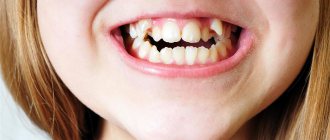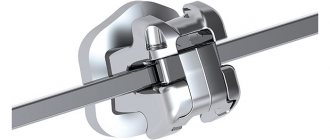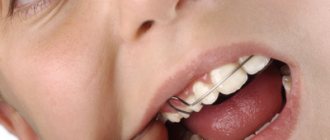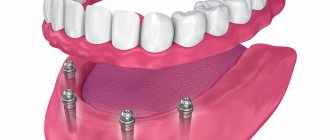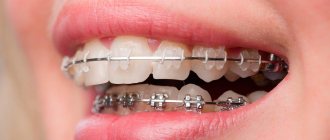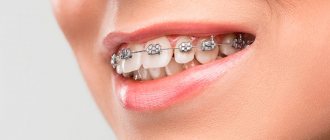At the initial appointment on November 17, 2022, mother and her daughter Nastya asked for “something invisible” to straighten their teeth. Since the child is in adolescence, we installed a non-removable expansion device on the teeth of the upper jaw, which is located inside the roof of the mouth, and small overlays on the teeth so that the teeth that do not close correctly do not wear out.
After some time, we approached the treatment of the child with braces. We drew up a treatment plan and agreed that we would install braces to correct the bite, achieving maximum aesthetics and dental health.
Based on the condition in the oral cavity, before starting treatment with braces, we took an anamnesis and took a photo.
Classification of bracket systems
At an appointment with an orthodontist, the patient will be offered different options for braces from those that the doctor considers optimal for a particular clinical case. When choosing which braces are best to install, you should focus on the following criteria:
- — type of fixation. There are ligature and self-ligating (or non-ligating) systems;
- - material of manufacture. In dentistry, braces are made from metal, ceramics or artificial crystal (sapphire);
- - location. There are external or vestibular structures, as well as internal or lingual ones.
When choosing, you need to consider: the cost of the braces system, the dentist’s recommendations, the importance of aesthetics and strength. If you are unsure which braces system to choose, don’t be afraid to ask your doctor questions.
Cost factor
Sometimes the system is chosen not by the doctor, but by the clinic. Therefore, patients often end up with unscrupulous doctors who install cheap orthodontic structures. A good braces system cannot be cheap. Because this is the result of many scientific developments and research. Therefore, our clinic uses only proven products. They have passed quality control and have international certificates.
When working with expensive materials, the doctor receives no less benefits than the patient:
- can treat complex tooth curvatures and malocclusions;
- it’s easier and faster to work with them;
- in the future, patients will not have problems with the design.
It is not necessary to remove teeth to install the device. During a consultation with an orthodontist in Propricus, the doctor will tell you how you can create a Hollywood smile without removing teeth.
Classification according to the principle of operation: ligature or non-ligature (self-ligating) braces
Depending on the type of fixation of the power arc to the clasps, braces can be ligature or non-ligature. Below we will look at the features of these two principles of system design.
Ligature braces involve the use of special elastic bands that gradually stretch. Therefore, the client has to visit the dentist monthly, or even 2 times a month, to check the tension of the arc and replace the ligatures if necessary.
Self-ligating braces (also known as non-ligating braces) - the clasps have special grooves in which the arch is fixed . This is a more modern solution that allows you to reduce the number of visits to the orthodontist to once every 2-3 months. This allows for smoother tooth movement. Also, it is easier to get used to non-ligature braces, and they help reduce treatment time and give a more predictable result.
Classification by material of manufacture
When thinking about which braces to choose based on the material of manufacture, you need to know the main advantages and disadvantages of each option:
- 1. Metal . The most durable classic systems that can cope with defects of any complexity and are the cheapest. Among the disadvantages: very noticeable, even if you install a self-ligating system with small locks, they can cause allergic reactions and irritation of the mucous membranes. Common ligature systems: Mini Diamond, non-ligature systems: Damon Q, Damon 3MX.
- 2. Ceramic . Braces are much less noticeable on the teeth and do not cause allergic reactions. The most common Damon systems are highly durable and efficient. The only drawback of such systems is their high cost.
- 3. Sapphire . They are made of artificial transparent material, due to which they are almost invisible on the teeth. However, they have increased fragility, so they are not suitable for advanced defects that require long-term correction. Popular option: Inspire ICE.
If you are unsure whether to choose ceramic or metal or sapphire braces, ask our orthodontist for advice. Depending on the severity of the defect and your wishes for aesthetics and cost, the doctor will select the best option.
Classification by location: vestibular and lingual braces
Another important criterion when choosing a brace system for bite correction is the location of the locks. There are two types of systems, each of which is actively used in orthodontics:
- 1. Vestibular braces (standard, visible). Classic designs that are attached to the front surface of the teeth. These braces allow you to correct any type of malocclusion, regardless of severity and complexity. However, even the most aesthetic clasps made of ceramic or sapphire will still be noticeable on the teeth.
- 2. Lingual braces (they are also called “invisible braces”, or internal). They are installed on the inner surface of the dentition, so they are completely invisible. Minus - they have a number of restrictions for use. In particular, they are not suitable for defects that are too complex .
If you are thinking about which braces are best for a girl, a shy child or an adult, then lingual systems are best suited. However, the decision must be made together with the orthodontist.
What dental problems did the child have?
Crowded teeth
Firstly, there was complex crowding of the child’s teeth in the lateral upper jaw:
Premolars in a child
One of the premolars on the left upper jaw did not fit into the dentition and occupied a palatal position. The premolar of the upper jaw could not take its place, since there was no place for it at all
:
Upper molar displacement
The girl’s large teeth—the upper molars— have moved forward to the place of the premolar
, and the wisdom tooth in the bone was already resting against the molar in front:
Anterior teeth of the lower jaw
In the frontal area, in the aesthetic zone of the smile, there was significant crowding
. In addition to crowding, the child’s lower jaw incisors and canines have protruded “up” from the bone tissue:
Violation of smile aesthetics
When smiling and talking, the lower front teeth were very visible, and the child’s upper front teeth were completely invisible
:
<
Impaired closure of teeth
In the anterior part of the teeth there was a discrepancy in closure: normally, the upper incisors of a 12-year-old child should overlap the lower incisors. In this situation, the lower lateral incisor rested on the upper lateral incisor, such closure erased these teeth
. In the future, with age, this incorrect closure of the incisors could lead to gum recession and, in fact, the loss of these teeth:
Fortunately, the patient’s mother knew about the consequences and brought her daughter to the orthodontist in time, realizing that in childhood and adolescence it is much easier to correct everything and without consequences. And the consequences are a high risk of tooth loss at a young age, implantation and prosthetics.
After a long break, at the beginning of February 2022
, we installed braces on the upper jaw.
Invisible braces
This is a separate criterion when choosing a bracket system. After all, many patients are interested in the issue of the visibility of the structure on the teeth. If aesthetics is more important to you, then “invisible” braces include the following options:
- - ceramic;
- - sapphire;
- - lingual.
The first two types of systems involve the use of a non-ligature type of fixation. The clasps on these braces are small and rounded. In addition to the aesthetics parameter, they also do not have a negative effect on the soft tissues of the oral cavity. The third type, lingual, involves installing the system on the inside of the teeth; as a result, the braces are not visible at all.
Is it worth choosing such “invisible” systems? The exact answer is up to you. We advise you to focus not on aesthetics, but on efficiency, on which the final result and the duration of the entire treatment depend!
Age from which you can install
This orthodontic appliance is used only on permanent teeth with fully formed roots. When such a load is placed on still unformed roots, they can simply dissolve. Therefore, before installing braces, a thorough diagnosis must be carried out, including an X-ray of the jaws. The optimal age for using braces is considered to be 12-14 years. At the same time, it is important not to miss the moment and contact an orthodontist at the MY ORT clinic on time, because the later the treatment begins, the more painful and lengthy it can be.
Which braces should a teenager or child choose?
Correcting the bite in children is a fairly common type of dental treatment. Parents often have to think about how to choose braces for a child or teenager. The best option is to listen to the advice of a pediatric orthodontist.
When discussing different options, it is worth taking into account the child's personality. If he is shy or has complexes, then it is better to install one of the “invisible” types of systems. But children, as a rule, are less concerned about aesthetics, so they are most often fitted with classic metal braces.
We check whether the child needs a visit to the orthodontist
There are a number of signs that indicate the need for orthodontic treatment in children:
- crowding and creeping of some teeth onto others;
- the presence of diastemas - large gaps between the teeth;
- Losing some baby teeth too early.
In addition, there are some hereditary factors that can influence the appearance of teeth in children. It has been proven that children of those people who have ever suffered from malocclusion and needed treatment will also be forced to resort to the services of an orthodontist to obtain an aesthetic and healthy smile.
The best braces for adults
Treatment of malocclusion in adults takes longer and is more difficult than in children. Therefore, the choice of braces must be approached with special care. The following criteria are important:
- — severity of the defect;
- - general condition of teeth;
- — aesthetics;
- — convenience;
- - price;
- - strength;
- - expected duration of treatment.
There is no particular braces system that could be considered the best. Different orthodontic structures are suitable for each clinical case. If you are most interested in aesthetics, you should get lingual braces. In cases where you need a cheaper option, classic metal systems are suitable. Moreover, regardless of the situation, doctors usually recommend installing self-ligating structures, because This will reduce the number of appointments with the orthodontist, and they are also more effective.
Braces for children 13 years old: when is the best time to start treatment
The optimal age for bite correction is adolescence. By this time, it is already worth discussing which braces are best for a teenager and deciding on the models.
By the age of 11-14 in children, the primary bite is completely replaced by a permanent one, and the strength of the enamel reaches its maximum values. But at the same time, the formation of bone tissue continues, which facilitates correction and reduces the time of orthodontic treatment for adolescents with braces.
Children of primary school age are also given braces after the appearance of permanent incisors. This is a system of limited functionality, and its task is to straighten the first molars and set the correct vector for the development of permanent occlusion.
Conclusion
Choosing the right brace system depends on many parameters. In modern orthodontics, there are many different designs, each of which has advantages, disadvantages and may be the best option for a particular situation. When choosing braces for malocclusion treatment, you must, in addition to your own requirements, consult with an experienced orthodontist. You can undergo a comprehensive examination and consultation with a doctor, and then get high-quality, effective braces in our dentistry.
Posted by:
Caring for your child's teeth after braces are installed
Many parents think that after installing braces, they will have to spend a lot of time on home oral hygiene: forcing the child to brush his teeth, watching him. However, difficulties may arise only in the first week after installation, when you will need to change your usual teeth brushing regimen. The process itself will take a little more time, but no major changes in dental care will occur.
Parents will need to monitor their child's diet. For example, with braces you cannot chew gum, eat toffees and similar sweets, or bite apples and other elastic fruits. These minor restrictions will not have to be observed for long, because children are given braces for an average of 6–12 months. You can get involved in the process and support your child, come up with a new interesting diet for the whole family and turn everything into a game - this will make it even easier to accept bite treatment.


